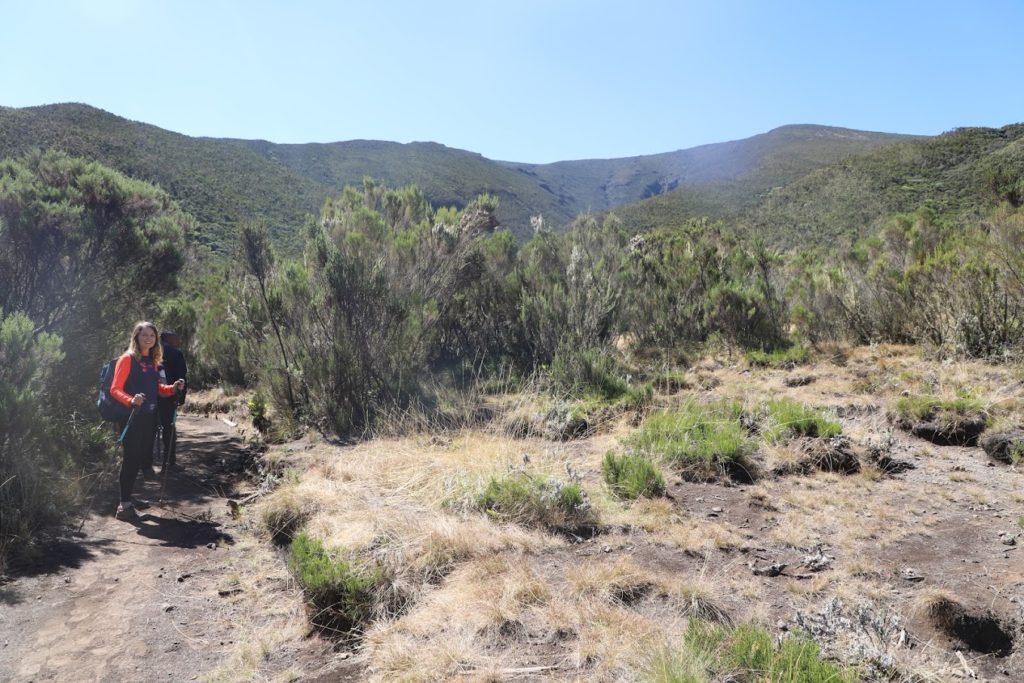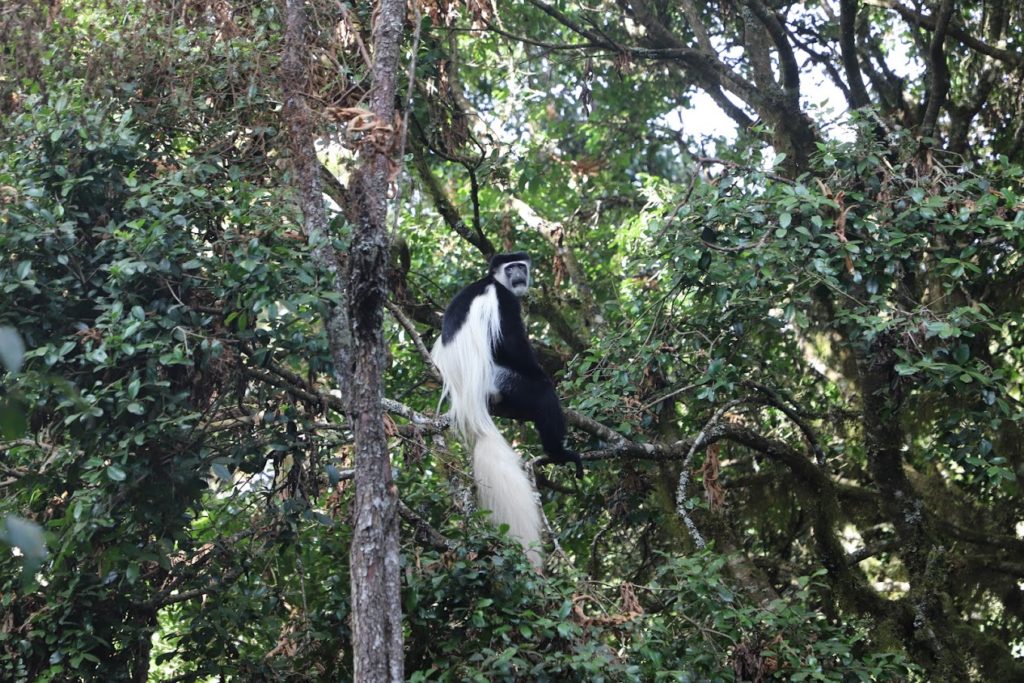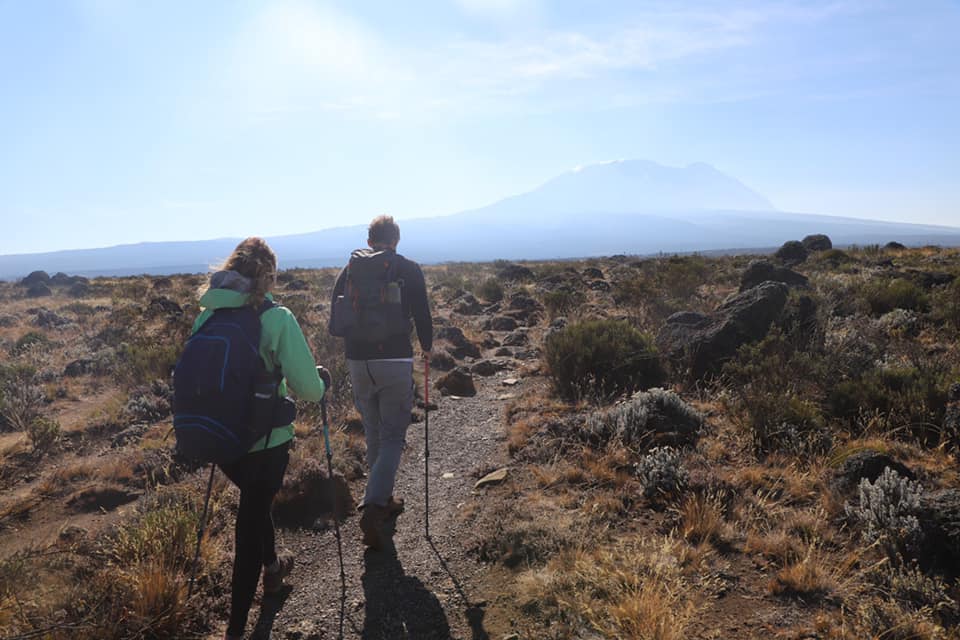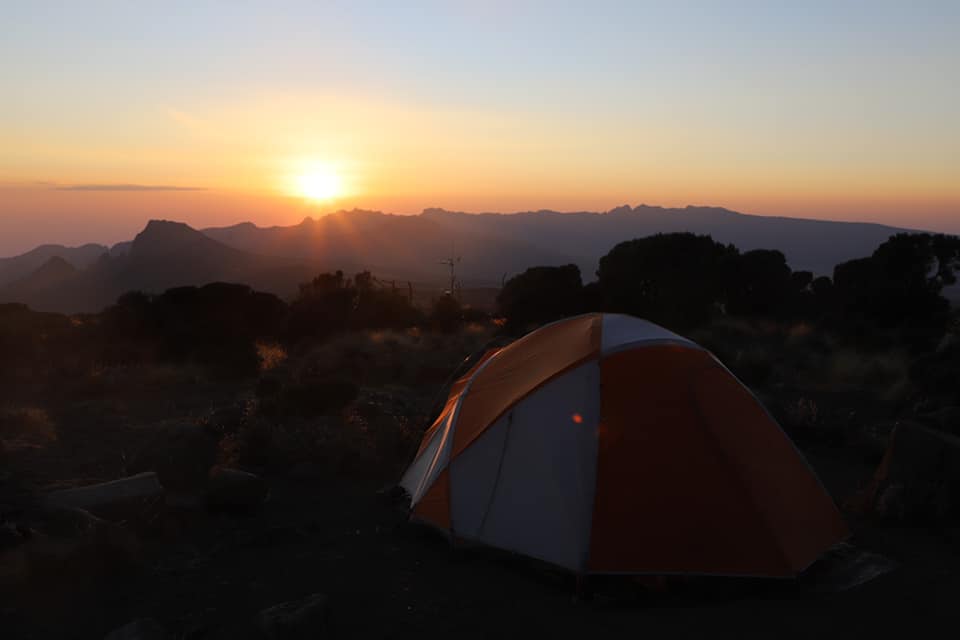Since I met Nick we had talked about climbing Kilimanjaro. Nick had already climbed Kilimanjaro and would make the joke that I cannot call the mountain ‘Kili’ until I had climbed it, so I thought was about time to do it! This is our story on how we made it to the roof of Africa.

We decided to do the 9-day Lemosho route with Wildlife Oasis Tours as the longer you walk the better your body acclimatises. The main reason people fail the climb is not due to physical fitness but because they are affected by the altitude. We got picked up in Arusha, a two hours drive from our starting point. Our bags were carefully weighed to make sure we did not sneak in more than 15kg and driven to the Lemosho Route Registration point, the Londorosi Gate at 2250m.
It is when you see all the porters weighing and putting on all their kit you realise these are the heroes of the mountain. Between the two of us we had 11 porters, 2 guides, 1 chef and 1 assistant cook. And whilst we carry just a daypack, everything else – from tents, food, folding tables and chairs is carried by an army of super-fit porters. To protect them, each porter is only allowed to carry a maximum of 20kg and everything is weighed before starting.
Day 1
The first day’s walk on the Lemosho route is relaxed to ease you into what is to come. Our guide, Nico led at a incredibly slow pace which feels infuriating to start with but make sense with the altitude. The mantra of the mountain is ‘Pole-Pole’ (pronounced Puh – o – leh, Puh – o – leh). In Swahili this mean ‘slowly, slowly’. The slower you go, the more oxygen you will get in your body and the better you will acclimatise. Drinking water is also very important to have a chance at reaching the summit.

It also gives the porters a chance of getting to the next camp and having everything set up before you get there. The first day started in walking uphill through the forest where we spotted colobus monkeys flying through the trees.

It was short day as it taken two hours for us to arrive at our camp, where our tents had already been set up.
Day 2
We continued further uphill through the forest. By the afternoon we had left the forest behind and entered the moorlands. One of the reasons I wanted to climb Kilimanjaro so much is they say its one of the few places in the world where you can pass through four climate zones in one journey: rainforest full of wildlife, moorland, through dry desert and then finally to the artic zone at the summit. We arrived to our tents already pitched and knew the next day would be time to start taking Diamox.

Day 3
We were at over 3600m now. We decided to take our first Diamox tablet to help with potential problems with altitude. So we took half a tablet and experienced one of the side effects, the need to wee more. Combined with the fact you’re drinking more water than normal to stay hydrated means you’re nipping behind a rock or bush every hour. A lot of the walking on the Lemosho route is about acclimatisation and was the reason for us picking this trail. It is deliberately an up and down route to help you acclimatise and make it much more likely that you will reach the summit successfully.
Day 4
This was all about getting to Lava Tower. Lava Tower is 300 foot tall rock formation formed from lava when Kilimanjaro was still an active volcano. Nico our guide explained the lava spurted out of the vent, cooled, and hardened making up the vent below. We then headed downhill to camp, through a fantastic landscape populated with weird trees.

These senecio trees or giant groundsels were weird and wonderful. They are native to the upper slopes of the mountains of East Africa and we were told they only grow new branches once every 25 years. From our photos some of these were huge so must have been hundreds of years old. Interestingly, they only grow near a good source of water so you know when a good drinking spot is coming up.

Walking through the giant lobelia plants did make you feel you were on another planet. It was one of my favourite parts of the hike due to the interesting plant life. We eventually made it to Baranco camp at 3900m.The camp is famous for being beneath the Barranco Wall. This is the steepest and technically tricky part of the ascent that we had to look forward to in the morning. A lot of walking on Kilimanjaro is plodding very slowly to acclimatise so was looking forward to being a bit more adventurous and climbing Barranco Wall.
Day 5
I think there is a lot more hype than necessary about Barranco Wall. If you’re afraid of heights it can be a challenge but it wasn’t the terrifying boulder scramble which we had expected. I think Barranco Wall from afar can look very daunting. But when you get closer your realise that it’s a lot less deadly than it looks, and you don’t need any climbing skills or equipment to ascend. To be frank its not the scariest part of Kilimanjaro. The leading cause of injury and death on Kilimanjaro is Acute Mountain Sickness (AMS) so if you walk slowly, drink plenty of water and have Diamox tablets on hand it should give you a good chance of succeeding.
Climbing up Baranco Wall involved grabbing onto the edges of the rocks and pulling ourselves up, all the time looking for the next place to put a foot or hand. It was slow going but was more fun than the usual walking. Porters would pass us on the way and it was astonishing to see how fast they would scale the wall with all the gear for camp passing us so quickly. We made the top of the Barranco Wall in two hours and were rewarded with the best view of the hike so far Kilimanjaro’s main peak, Kibo.



We had gained another 300m of altitude and felt like we were living about the clouds.

After Barranco wall the last part is mostly downhill with one last steep bit to reach our home for the night: Karanga Camp at 3995m. We would say Karanga camp site is the most scenic of all the Lemosho Route campsites. We had the stunning view of Mount Meru, floating above the clouds so would be rude not to have breakfast with this as the backdrop in the morning.

Day 6
The penultimate night before the summit involved getting from Karanga campsite to the base camp Barafu at nearly 4700m. We took it nice and slowly and always followed the mantra of our guiding saying ‘pole pole’ which means ‘slowly slowly’ in Swahili. The last part of the hike was mostly barren so we were looking forward to all the winter landscapes that would come with summit day.


We spent most of that day discussing summit night and feeling nervous/excited for the next day. By this point, we both felt ready that acclimatisation had done its thing. That afternoon was spent getting ready and deciding what to pack. Then the sun went down and summit night was finally upon us.
Summit Night (Day 7)
When planning the Lemosho route our guide said there was the option to summit during the day and then spent a night at the crater. We would be sleeping at altitude of 5895m for one night but for the views it seemed worth it. Especially as we would start summiting from 5am so could enjoy the views as majority of people summit at night.
We started the climb to the summit at 5am. It was still very dark and I found it frustrating with nothing to look at but Nick’s feet in front of me so I couldn’t wait for the sunrise to start. Apart from boredom I started feeling very hot. I had worn a fleece and jacket and it was too much that I had a little wobble at the start. After removing my jacket and fleece and hiking in just two layers of long shirts I started to feel a lot better. Then Nick had a little wobble as it was difficult doing the hike in the altitude and keeping our motivation. We then got past our hurdles and started making progress especially when we saw the sunrise.

We can only describe seeing the sunrise on summit day as GLORIOUS! It lifted our spirits like nothing else and felt there was an end in sight. We lost track of how long we had been walking with the sun coming up it meant things were only going to get lighter and warmer. We could look around and see where we were going rather than starring into darkness. It was the best feeling EVER!



With the sunrise coming up it was not over yet. I found the last 200m of the vertical ascent quite a struggle. My 10kg rucksack which I had been able to carry with no problem felt like a tonne. Everything was feeling heavier and I felt a bit nauseous but I started to see the sign for Stella Point. Although its not quite the top from Stella Point its only another hour or so to reach Uhuru Peak, the summit. Seeing our porters run to Stella Point and everyone taking photos of us brought such a smile to our faces and gave us renewed determination. Many of the porters had not been to the crater before as their work finishes at Barafu camp so seeing our porters running down full of joy made the trip worth it.
Now it was time to head to the summit and reach Uhuru Peak. The hour walk to Uhuru Peak is beautiful passing snow and seeing what remains of Kilimanjaro’s glaciers (sadly just a fraction of their former selves due to global warming). We bumped into another English man who we met at the start and was on his way back from Uhuru Peak. He offered us words of encouragement and reassured us we did not have far to go. Then finally after walking through the snow we made it!!!

Being on Nick’s shoulders was much harder than it looked. When you reach the top you’re exhausted because of the altitude and hiking over 10 hours to get there. Nick used every piece of strength he had left to capture the moment as it felt like I weighed a tonne at the time. We enjoyed the view at the top for a while and then started our descent to crater cramp for one final night.
Crater Camp (Day 7)
We had one more night to spent at the crater. By the time we started descending from Uhuru Peak to crater camp which was about an hour away and at the same altitude we did start feeling nauseous. The extra hike for crater camp felt like hours and we started to run out of water fifteen minutes before getting to camp. We used every piece of strength to get us to crater camp.
We finally arrived and the porters were chuffed we made the climb. They had already got all the camp setup and lunch for us when we arrived. We found out one of the porters was struggling with the altitude so two of the porters were going to accompany him down. Kilimanjaro is tough and even the strongest porters who have done the hike 100s of time can be affected by altitude. It is important to understand your limits and know when to turn back.



After having lunch we spent the rest of the time walking round the crater camp and admiring the glaciers. It was worth the extra night and felt very special. After the sunset it felt like the longest night of our lives. We both could not sleep because of altitude, were very cold and could not wait for a hot shower so decided the next day to leave as early as we could from 6am.
The descent (Day 8/9)
After following the mantra of Kilimanjaro ‘pole pole’ (slowly, slowly in Swahili) it was time to do the opposite on the descent and surf down the mountain. Much of the path was deep, loose gravel and we slid down the mountain at record speed with the biggest smiles on our faces. We could now say we climbed ‘Kili’. If that upsets you, then sorry. You will just have to go and climb it, and then you can say ‘Kili’ too.
Takeaways
Each year 35,000 people attempt to summit Kilimanjaro. However, only around half are successful due to altitude sickness and other physical problems. It is only when you climb the mountain and see the team of porters, guides, and cooks that you realise climbing Kilimanjaro is a massive industry in Tanzania. Becoming a guide is one of the most sought after jobs which is highly lucrative career. It is one that nearly every porters aspires to getting licensed and certified is difficult. I cannot think of many harder jobs than being a porter on Kilimanjaro.
Throughout our eight days we will always remember the heroes of the mountain the porters. Carrying our tents, rucksacks, cooking equipment, tables, chairs on their backs. No one could survive even a day on Kilimanjaro, let alone make it to the top without an enormous team of guides, porters, and cooks. These guys work phenomenally hard and never show the slightest weariness when your there. The true heroes of the mountain and here are some of the fantastic guides and porters that led us to success.